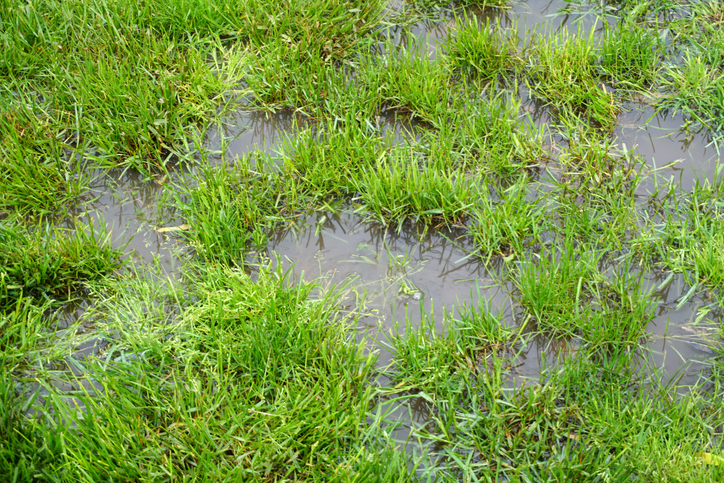Why is my rainwater soakaway overflowing? Plus — how to unblock it
Soakaway overflowing can arise if the surface water drainage on your property is ineffective

Why is my soakaway overflowing might be a question you need answering when faced with a soggy driveway. And the answer, generally surrounds the soakaway underneath not working as it should.
This could be due to the surface water drainage system being blocked or perhaps not being installed correctly. But if the problem isn't fixed, any flooding that might occur as a result can not only cause damage to your own property but can also result in the discharge of water onto neighbouring properties, potentially causing legal disputes.
We spoke to property flood resilience champion Mary Long-Dhonau OBE– AKA ‘Flood Mary’ - about the issue and have put together some expert advice on unblocking a soakaway and keeping it in top shape.
Why soakaways are worth adding to homes
A soakaway is simply a hole dug into the ground, filled with rubble or other material, that allows a greater area for surface water to percolate back into the earth to prevent pooling - or even flooding - on the surface when heavy rain falls.
Soakaways are a form of sustainable drainage system (SuDs), soon to become a legal requirement, designed to manage and control surface water runoff, particularly in urban areas in an environmentally-friendly and sustainable way.
Soakaway construction involves digging a large hole in the ground and stacking soakaway or attenuation crates within it. The crates feature voids, allowing large volumes of water to seep back into the ground.
If you are planning on adding a soakaway to your driveway or front garden, it is worth looking about our expert guide on how to build a soakaway.
Get the Homebuilding & Renovating Newsletter
Bring your dream home to life with expert advice, how to guides and design inspiration. Sign up for our newsletter and get two free tickets to a Homebuilding & Renovating Show near you.
What are the common causes of rainwater soakaways overflowing?
There are several causes as to why a soakaway would overflow. These include:
- Debris blockage such as leaves and branches. If these or other materials build up, they can prevent water from being collected and filtered back into the ground
- A buildup of silt or sediment through non-maintenance
- Infiltration of tree or plant roots that block the soakaway pipes
- Inadequate size could affect drainage capacity
- Exceeded its life expectancy, which is at least 25 years
- High-intensity rainfall can overwhelm a soakaway’s capacity
How do you unblock a soakaway?
Any work to unblock a soakaway is going to require some tough manual work – the main methods include:
- High-pressure water jets can help dislodge blockages. On most occasions a blockage can be rectified with high-pressure water jets, gaining access to the pipework and backwashing it to drag out the silt and leaves, so that it is left clear and running.
- Physically removing any visible obstructions or debris. Such blockages are usually a result of a failure in the silt traps and filters of the system. Silt traps should be regularly checked and maintained.
- Drainage rods can also assist in breaking up matter
- Repair or replacement. If vital components have lost their structural integrity it may be the only option. Bear in mind older soakaways may not be covered by insurance or warranties.
- You may need to move the soakaway to a different area, especially if flooding is occurring near a house or other building.
Homeowners should always seek help from a professional drainage expert to ensure your soakaway is fit for purposes and operating as efficiently as possible.
What steps can you take to prevent overflows and blockages?
When it comes to any form of flood risk management, an important step is maintenance of equipment – and that even includes sustainable drainage solutions, including soakaways. Mary says owners should schedule periodic inspections to ensure it is performing as it should be.
She adds: "I would also suggest installing leaf guards in the guttering to help reduce the amount of leaves or debris from entering the soakaway in the first place.
"Consider diverting excess water to water butts, which is not only great for the environment, but reduces the burden on the soakaway.
"Perhaps make sure that the general area around the soakaway is free from plants with aggressive root systems."
Sam is based in Coventry and has been a news reporter for nearly 20 years. His work has featured in the Mirror, The Sun, MailOnline, the Independent, and news outlets throughout the world. As a copywriter, he has written for clients as diverse as Saint-Gobain, Michelin, Halfords Autocentre, Great British Heating, and Irwin Industrial Tools. During the pandemic, he converted a van into a mini-camper and is currently planning to convert his shed into an office and Star Wars shrine.

